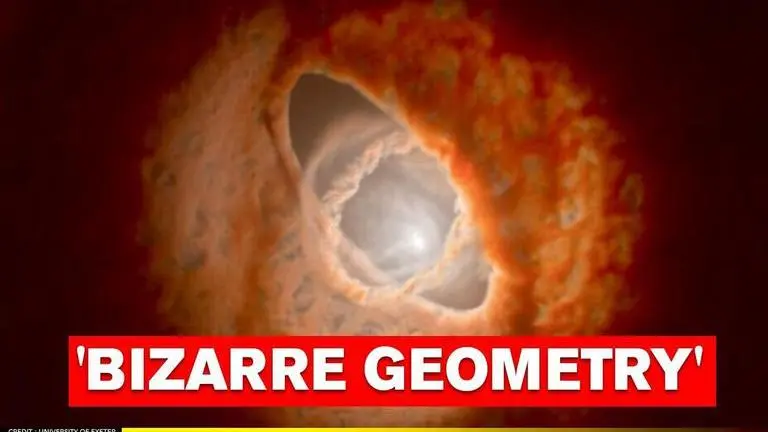Updated 6 September 2020 at 18:09 IST
Scientists discover 'misaligned and warped' circumstellar planetary system
An international team of experts, led by scientists at the University of Exeter, found a unique stellar system with tilted, multiple stellar constellations.
- Science News
- 4 min read

Scientists have discovered a peculiar multi-star planetary system, different from the solar system with tilted rings and warped circumstellar disc around multiple stars. In research published by the University of Exeter on its website, an international team of experts, led by astronomers at the University of Exeter, found a unique stellar system with tilted, multiple stellar constellations quite similar to Star Wars’ Tatooine surrounded by inclined dust and gas rings. The findings were recorded on the European Southern Observatory’s Very Large Telescope (VLT), Georgia State University’s Center for High-Angular Resolution Astronomy telescope array (CHARA), and the Atacama Large Millimeter or the submillimeter Array (ALMA).
The instruments’ observations gave new insights to the scientists about how stars and planets formation took place inside the rare rotating, circumstellar discs of dense dust and gas surrounding young stars. The findings were a part of a large program that intended to discover the stellar system using the infrared imager, called MIRC-X. The CHARA telescope array combined at least six telescopes observations that depicted intense lights. MIRC-X was designed by the Universities of Michigan and Exeter as part of a European Research Council-funded research project.
An international team of experts, led by astronomers at the University of Exeter, has identified a stellar system where planet formation might take place in inclined dust and gas rings within a warped circumstellar disc around multiple stars.
— University of Exeter (@UniofExeter) September 4, 2020
Read more: https://t.co/a8ctxUwWuB pic.twitter.com/5Lz8pOh4Qq
While the Solar System was previously known to be as flat, with the planets all orbiting in the same plane, the new findings proved that it was not always the case. The research found newly typed of planet-forming discs around multiple stars, similar to GW Orionis. Located just 1,200 light-years away in the constellation of Orion, the stellar system was observed to have only had three starts and a deformed, broken-apart disc surrounding them.
“We’re really excited that our new MIRC-X imager has provided the sharpest view yet of this intriguing system and revealed the gravitational dance of the three stars in the system. Normally, planets form around a flat disc of swirling dust and gas– yet our images reveal an extreme case where the disc is not flat at all," said Stefan Kraus, professor of astrophysics at the University of Exeter, who led the research published today in Science.
Advertisement
Further, he added, the system “is warped and has a misaligned ring that has broken away from the disc. The misaligned ring is located in the inner part of the disc, close to the three stars. The effect is that the view of a potential planet within this ring looks remarkably like that of Tatooine, of Star Wars fame.” The scientific team used the SPHERE instrument on ESO’s VLT and with ALMA, to study the inner ring and find that they were misaligned, unlike our solar system.
Advertisement
[Astronomers looked at GW Orionis with the ALMA telescope array (left, blue) and the SPHERE instrument on the Very Large Telescope (right, red), both in Chile. The ALMA observations revealed the disk’s tri-ringed structure and rings’ deformed shapes in detail. Credit: University Of Exeter]
“The team observed shadows that this ring casts on the rest of the disc. This helped them figure out the 3D shape of the rings and overall disc geometry,” the research revealed.
30 Earth masses of dust
It was also found that the inner ring of the planets consisted of over 30 Earth masses of dust, which could be enough to form newer planets.“Since more than half of stars in the sky are born with one or more companions, this raises an exciting prospect: there could be an unknown population of exoplanets that orbit their stars on very inclined and distant orbits,” Alexander Kreplin of the University of Exeter, said. “Any planets formed within the misaligned ring will orbit the star on highly oblique orbits and we predict that many planets on oblique, wide-separation orbits will be discovered in future planet imaging surveys,” he added.
[ALMA, in which ESO is a partner, and the SPHERE instrument on ESO’s Very Large Telescope have imaged GW Orionis, a triple star system with a peculiar inner region. Credit: Univ. Of Exeter]
Published By : Zaini Majeed
Published On: 6 September 2020 at 18:09 IST


